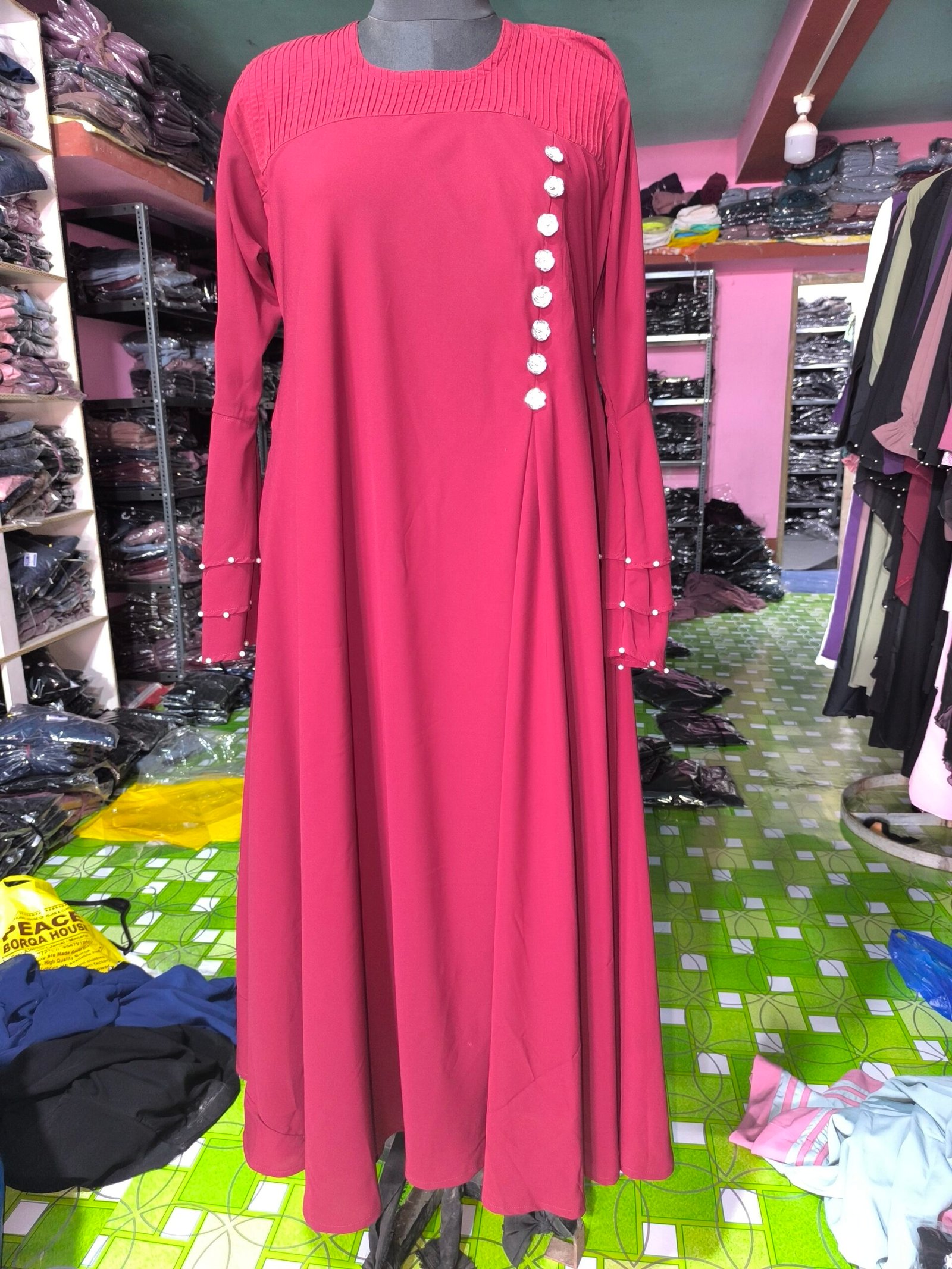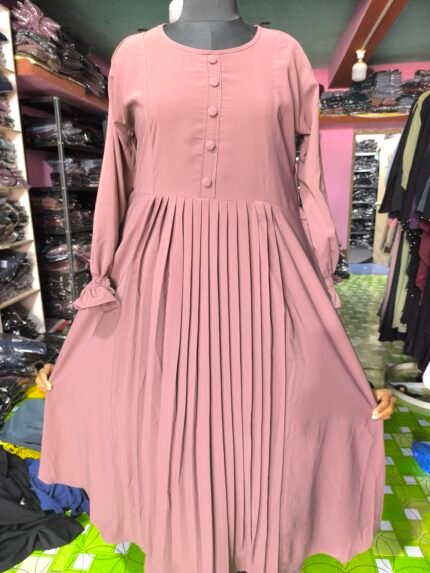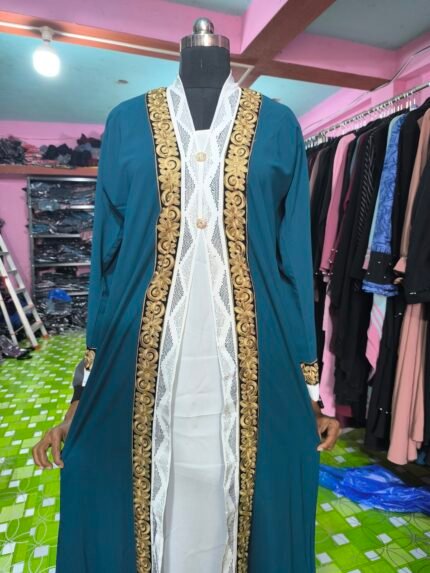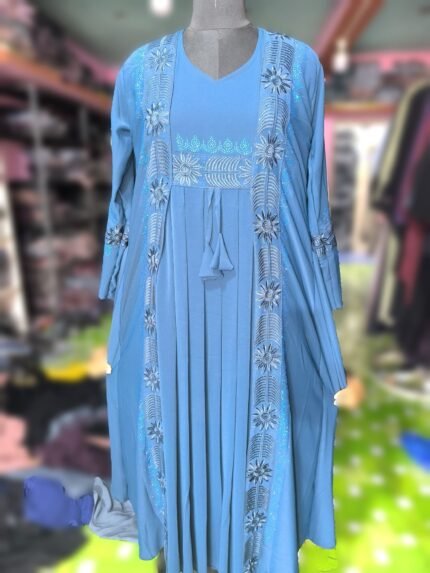Best Customize Design Ladies Abaya Burqa-2024
The burqa silver variant is equally as stunning as the gold one, and it will add even more sparkle to your occasion. You will look as glamorous as a star wearing this gorgeous design. After your duties as a maid of honour or a bridesmaid are over, wear the entire costume to wow the guests at your loved one’s wedding. For a more modern style, match the glittery cardigan with jeans and a stylish shirt. When worn with a structured jacket or blazer, the inner abaya is even more stunning; the lines create a tactile aesthetic for a three-dimensional look that will guarantee you draw attention wherever you go.
baitulburqa: Cultural, Religious, and Social Perspectives
baitulburq- is one of the most recognizable and, at times, controversial garments associated with Islamic culture. It is a full-body covering worn by some Muslim women, designed to conceal the body and face, with a mesh screen for the eyes to allow for visibility. While is a symbol of modesty and religious observance for many, it has also become the focal point of global debates on women’s rights, religious freedom. This article will explore the historical, cultural, religious, and social dimensions of the bur, delving into why it remains a complex issue today
Cultural Origins

baitulburqa The has deep historical and cultural roots, dating back centuries before the advent of Islam. The practice of veiling or covering women’s bodies was prevalent in various ancient civilizations, including the Byzantine and Persian empires, as a marker of social status and modesty. When Islam spread across the Middle East and beyond in the 7th century, other forms of veiling were adopted into Muslim customs and came to be associated with the religious concept of hijab, which refers to modesty and privacy, especially concerning women’s dress.
=However, it’s important to note that the Veil is not a uniform practice across all Muslim societies. While some regions, particularly in Afghanistan, parts of Pakistan, and certain Gulf states, have historically maintained the use of the Veil , other Muslim-majority countries have seen different interpretations of modest dress. For instance, in many parts of North Africa, the Middle East, and Southeast Asia, women wear various styles of headscarves, such as the hijab or niqab, which differ from the full-body covering . The burqa is thus both a cultural artifact and a religious symbol, with its significance varying by geography and interpretation–com-most-advanced-and-best.
Religious Significance of the Burqa
In Islam, modesty is an important tenet, and both men and women are encouraged to dress in a manner that reflects their religious values. The concept of hijab encompasses more than just physical clothing; it refers to the modesty of behavior, speech, and appearance. Many Muslim women view the Veil as a physical manifestation of this principle, expressing their devotion and faith through their attire. The Veil is often worn as an act of religious observance, symbolizing a woman’s commitment to modesty, privacy, and piety in her relationship with God.
baitulburqa-The Controversy Surrounding.
baitul Veil -Despite its significance to many Muslim women, the Veil has become a controversial topic, particularly in Western countries. In the post-9/11 world, the Veil has often been associated with discussions around terrorism, national security, and the clash between Islamic and Western values. This has led to a growing divide in the perception of the Veil , with many viewing it as a symbol of oppression and gender inequality, rather than a voluntary expression of faith.
baitulburqa-In countries like France, Belgium, and Switzerland, the Veil has been at the center of heated debates over religious freedom, women’s rights, and national identity. France, in particular, has taken a strong stance on secularism, enacting laws in 2010 that ban the wearing of full-face veils, including the Veil , in public spaces. This law, known as the ” Veil ban,” was justified on the grounds of promoting social integration, gender equality, and public security. However, critics argue that such laws target Muslim women, stripping them of their right to choose how they dress and marginalizing them from public life.
baitulburqa-Proponents of the burqa ban claim that the garment undermines gender equality by reinforcing patriarchal norms, where women are expected to cover their bodies while men face no such restrictions. They argue that the burqa is often imposed on women, especially in conservative societies, where women may have little say in whether or not they wear it. From this perspective, banning the Veil is seen as a way to empower women and promote their participation in public life.
baitulburqa-On the other hand, opponents of the ban argue that it infringes on religious freedom and individual autonomy. Many Muslim women who choose to wear the Veil do so voluntarily, as an expression of their religious and cultural identity. By outlawing the Veil , critics argue, governments are effectively punishing women for their personal choices and forcing them to choose between their faith and their ability to participate in public life.
baitulburqa-The Veil and Women’s Rights
baitulburqa-The debate over the Veil often intersects with broader discussions about women’s rights and feminism. In many ways, Veil embodies the tension between cultural relativism and universalism. On one hand, there is a strong argument that women should have the right to dress according to their religious beliefs and cultural practices, free from government interference. On the other hand, some feminist critics argue that the Veil reinforces traditional gender roles that subordinate women to men, and that true gender equality requires challenging these norms.
baitulburqa-This divide is particularly evident within the global feminist movement. Some feminists support the right of Muslim women to wear the Veil as part of their freedom of choice, while others argue that the garment is inherently oppressive and incompatible with feminist ideals of gender equality. This tension reflects the broader challenge of balancing respect for cultural diversity with the fight for universal human rights.
baitulburqa-Conclusion: A Multifaceted Symbol

baitulburqa-The Veil is far more than a simple garment—it is a complex symbol with layers of meaning that vary depending on context, culture, and personal choice. For some women, it is an expression of religious devotion and cultural identity, while for others, it is seen as a source of controversy and debate over women’s rights and religious freedom. baitulburqa-The global discourse surrounding the burqa is emblematic of larger conversations about the intersection of religion, culture, and modernity in a rapidly changing world.
baitulburqa-Rather than viewing the Veil through a single lens, it is essential to understand its diverse meanings and the ways in which it impacts the lives of women who wear it. While some see the burqa as a form of repression, others view it as a personal choice that reflects their religious values. Ultimately, the is serves as a reminder of the complexities of identity and the challenges of fostering tolerance and understanding in an increasingly globalized world.
Brand: Baitul Burqa Stitching Type: Stitched Occasion: Casual Work Plain Look: Traditional Sleeve: Full Sleeve Neck Style: Round Neck Color: Rose Red Fabric: Nida










Reviews
There are no reviews yet.